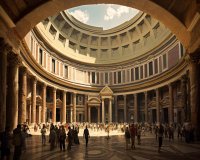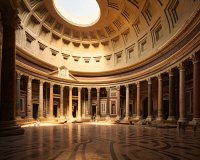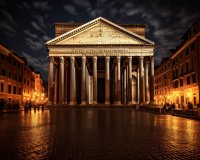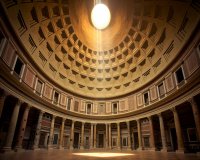Rome’s Pantheon: A Glimpse into Modern Italian Culture
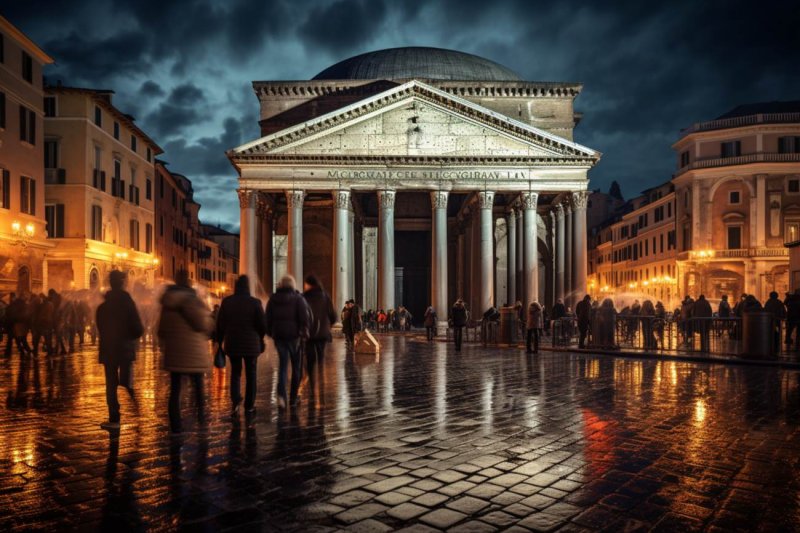
Rome's Pantheon: A Glimpse into Modern Italian Culture
The Pantheon, a magnificent architectural marvel located in the heart of Rome, is not just a historic monument but a symbol of Italy's rich cultural heritage. This ancient temple turned church has stood the test of time, showcasing the enduring influence of Roman culture on modern Italy. Let's take a closer look at the Pantheon and its significance in contemporary Italian culture.
Ancient Origins
Constructed in 126 AD by the Roman Emperor Hadrian, the Pantheon was originally a temple dedicated to all the gods of Ancient Rome. The word "Pantheon" itself means "all gods" in Greek, reflecting the inclusive nature of this architectural masterpiece.
One of the most remarkable features of the Pantheon is its massive dome, which was a groundbreaking engineering achievement of its time. The dome remains the largest unreinforced concrete dome in the world, showcasing the Romans' architectural prowess and their innovative use of concrete, a material they perfected.
Transformation into a Church
During the early Christian era, the Pantheon was transformed into a Christian church, which it remains to this day. This conversion allowed the Pantheon to survive the waves of destruction that many pagan temples faced during the Christianization of Rome.
The Pantheon's adaptation into a church reflects the melding of Roman and Christian cultures, a pivotal moment in Italy's cultural history. It also symbolizes Italy's enduring commitment to preserving its historical treasures.
Modern Italian Culture
Today, the Pantheon continues to play a significant role in modern Italian culture. It stands as a symbol of Italy's historical continuity, connecting contemporary Italians with their Roman ancestors. Tourists from around the world visit the Pantheon to witness this living testament to Italy's rich past.
The Pantheon's architectural influence is also evident in modern Italian design. Its iconic dome has inspired countless architects, and you can see echoes of its grandeur in many contemporary Italian buildings.
Tourism and Community
The Pantheon is not just a tourist attraction; it's an integral part of the local community. Nearby cafes and restaurants offer visitors and locals a chance to immerse themselves in the vibrant atmosphere of Rome. The Pantheon square is often filled with street performers and artists, adding to the cultural tapestry of the area.
Cultural Events
The Pantheon occasionally hosts cultural events, including concerts and exhibitions. These events further enrich the connection between modern Italy and its historical roots, making the Pantheon a hub of cultural activity in the heart of Rome.
Conclusion
In conclusion, the Pantheon is not just a relic of the past; it's a living symbol of Italy's cultural continuity and its ability to blend history with the present. The Pantheon's transformation from a pagan temple to a Christian church and its continued relevance in modern Italian culture are testaments to Italy's rich and enduring heritage.
Visiting the Pantheon provides a glimpse into the heart of Italian culture, where history, art, and community come together under the iconic dome of this ancient architectural wonder.
Pantheon Guided Tour
Embark on an enriching journey through the remarkable Pantheon accompanied by a knowledgeable local guide. Marvel at the Pantheon's awe-inspiring oculus and pay homage at Rafaelo's tomb. Immerse yourself in tales of Ancient Rome and Michelangelo's influence during this guided exploration.
Activity Details
Activity provider: TICKETSTATION SRL
Customer Rating: 4.6 / 5 based on 190 reviews
Activity Highlights
- Enjoy an intimate small-group tour
- Discover three of Rome's top 10 attractions
- Gain insights into Ancient Rome's history from your expert local guide
Full Description
Your experienced guide will delve into the artistic genius of Michelangelo and his portrayal of Christ on the cross. Explore the Basilica of Neptune, the ancient thermal baths, and the original Roman street level. Witness fascinating flood marks and exquisite marble freezes that narrate intriguing stories. Step inside the Pantheon, beholding its mesmerizing oculus and paying homage at Rafaelo’s tomb. Throughout this journey, absorb a wealth of information about three of Rome's top ten attractions.
Includes
- Guided tour
- Entry fee
- Food and drink
- Transportation
Meeting Point
Meet your guide adjacent to "L'Antica Salumeria" shop at Piazza della Rotonda 4.
Important Information
- The Pantheon is a sacred site, so please dress appropriately, ensuring shoulders and knees are covered.
- Wear comfortable shoes for the tour.
Price: From € 37 per person
Check availability and reserve now, paying later to secure your spot without any upfront payment.
Consider gifting this enriching experience to a loved one!
Similar Tours
- Rome: Pantheon Official Audio Guide with Fast Track Ticket - 35 minutes to 1 hour, optional audio guide
- Rome: Pantheon Skip-the-Line Entry and Guided Tour - 45 minutes, skip the line
- Rome: Pantheon Museum Guided Tour with Skip-the-line Ticket - 1.5 to 2 hours
Customer Reviews
Overall rating: 4.6 / 5 based on 190 reviews
Guide: 4.8/5 | Value for Money: 4.4/5 | Service: 5/5 | Organization: 5/5
Recent Review:
Reviewer: An enthusiastic traveler from Australia
Date: June 24, 2023
Rating: 5/5
Review: Job was an awesome guide - engaging, entertaining, and informative. His tips for the perfect selfie were on point! Highly recommend this tour.
History and Significance of the Pantheon in Rome
The Pantheon, located in the heart of Rome, is one of the most iconic and well-preserved ancient structures in the world. Its rich history and architectural significance make it a must-visit for tourists and a subject of fascination for historians and architects alike. Let's delve into the history and importance of this magnificent edifice.
The Pantheon's Historical Origins
The Pantheon, whose name translates to "temple of all the gods," has a history dating back to 27 BC. It was commissioned by Marcus Agrippa during the reign of Augustus, the first Emperor of Rome. The original purpose of the Pantheon was as a temple dedicated to the Roman gods. Unfortunately, the original structure was destroyed by fire in 80 AD, but it was soon rebuilt by Emperor Domitian. The current structure we see today largely dates from this reconstruction.
One of the most remarkable aspects of the Pantheon's history is its transformation in 609 AD when it was consecrated as a Christian church. This conversion contributed to its preservation over the centuries, as many Roman temples were destroyed or repurposed during the Christianization of Rome.
Architectural Marvel of the Pantheon
What truly sets the Pantheon apart is its innovative and influential architectural design. The Pantheon is renowned for its dome, which was the largest in the world until the construction of the Florence Cathedral's dome in the 15th century. The dome's groundbreaking design features a perfect hemisphere, and its construction is a testament to the remarkable engineering prowess of the ancient Romans.
One of the most remarkable aspects of the Pantheon's dome is the oculus, a circular opening at the top that allows natural light and, at times, rain to enter the building. This architectural marvel not only serves as a source of illumination but also adds to the mystical ambiance within the structure.
Significance in Architecture
The Pantheon has been a source of inspiration for architects for centuries. Its dome has been studied and admired for its structural integrity and beauty. The precision with which it was constructed, with decreasing layers of concrete as it rises, demonstrates the advanced knowledge of ancient Roman engineers.
Throughout history, countless buildings and monuments have drawn inspiration from the Pantheon's architectural elements. The United States Capitol in Washington, D.C., for example, incorporates Pantheon-inspired elements in its neoclassical design, paying homage to this ancient marvel.
Tourist Attraction and Cultural Symbol
Today, the Pantheon is a major tourist attraction, drawing visitors from all over the world. Its historical significance and architectural brilliance make it a symbol of Rome's enduring legacy as the "Eternal City." Visitors marvel at the grandeur of the Pantheon, explore its interior, and experience the interplay of light and shadow created by the oculus.
Additionally, the Pantheon remains a symbol of the seamless blend of ancient Roman paganism and Christian tradition. It's a unique example of how history and culture evolve, adapt, and coexist within the same architectural space.
Conclusion
The Pantheon in Rome stands as a testament to the ingenuity of ancient Roman engineering and the enduring power of architecture to inspire awe and admiration. Its rich history, innovative design, and cultural significance have made it an enduring icon that continues to capture the imagination of people around the world.
Rome: Pantheon Official Audio Guide with Fast Track Ticket
Explore Rome's impressive Pantheon and enjoy insightful commentary from your audio guide. Learn about its fascinating history and how it was converted from a pagan temple to a Christian church.
Make your way to the Pantheon to explore the best-preserved monument of ancient Rome. Collect your audio guide at the desk inside the Pantheon to begin learning about its fascinating history.
The Pantheon, built between 25 and 27 B.C., is the only ancient Roman building that has remained nearly intact through the centuries. Dedicated to all the gods of Pagan Rome, the temple was built by the Emperor Hadrian on the site of an earlier temple commissioned by Marcus Agrippa during the reign of Augustus.
Highlights:
- Unravel the history of the Pantheon on the official audio-guided tour
- Admire the revered temple and mausoleum of the Pantheon
- Marvel at the architectural features like the oculus of the huge dome
- Donate to the Basilica of Santa Maria ad Martyres by booking this tour
Includes:
Pantheon audio guide
Pantheon skip-the-line entry ticket (if option selected)
Donations to the Basilica of Santa Maria ad Martyres
Important information:
- Access to the Basilica is only permitted to visitors wearing suitable attire (no shorts, vests, or sleeveless tops)
- A valid ID (passport, ID card, driver's license) or credit card will be required as a deposit in order to borrow the audio guide. Photocopies, pictures on the phone, student cards, and digital IDs aren't accepted
- The Pantheon is subject to anticipated closures, postponed openings, masses, concerts, or other events that may variate the service time
Likely to sell out from $10.55 per person.
The Pantheon in Contemporary Italian Culture: A Timeless Icon in Rome
The Pantheon, a magnificent architectural wonder in the heart of Rome, has held a special place in Italian culture for centuries. Its timeless beauty and historical significance continue to influence contemporary Italian culture and leave an indelible mark on the city's landscape.
Originally built by the Roman Emperor Hadrian between 118 and 125 AD, the Pantheon stands as a testament to the architectural prowess of the ancient Romans. Its perfectly preserved dome, considered a marvel of engineering, is a prime example of classical Roman design and has been a source of inspiration for architects and artists throughout the ages.
Today, the Pantheon is not just a historical site but a thriving symbol of Italian culture and heritage. It has been featured in numerous films, books, and works of art, further solidifying its place in contemporary Italian culture.
Architectural Marvel
The most striking feature of the Pantheon is its dome, which is a masterpiece of engineering even by modern standards. It remains the world's largest unreinforced concrete dome, and its design has been studied and admired by architects and engineers for generations. This remarkable architectural achievement has left an enduring legacy in the world of construction and design.
Visitors from all over the world come to marvel at the Pantheon's grandeur. As they step inside, they are greeted with the oculus, a circular opening at the center of the dome that allows sunlight to pour in. This architectural feature is not only beautiful but also serves as a symbolic connection between Earth and the heavens.
Cultural Significance
Throughout its long history, the Pantheon has served various purposes, from a temple dedicated to the Roman gods to a Christian church. This adaptation showcases its cultural and religious significance. The Pantheon's transformation into a church, known as Santa Maria ad Martyres, helped preserve it through the centuries and contributed to its continued relevance in Italian culture.
Today, it's not just a place of worship or a tourist attraction; it's a cultural touchstone. Many cultural events, concerts, and exhibitions are held within its hallowed walls, celebrating the fusion of history, art, and modernity. The Pantheon is a symbol of Italy's ability to embrace its past while remaining relevant in the contemporary world.
Artistic Inspiration
The Pantheon's influence extends far beyond its physical presence. Artists, painters, and writers have drawn inspiration from its grandeur for centuries. Its iconic dome, the play of light and shadow within its interior, and the sense of awe it instills have all found their way into various forms of artistic expression.
One famous representation of the Pantheon can be found in Raphael's "The School of Athens," a fresco in the Vatican. The building depicted in the background is believed to be the Pantheon, further cementing its status as a timeless symbol of Italian culture.
The Pantheon in Pop Culture
The Pantheon has also made appearances in contemporary popular culture. It has been featured in blockbuster movies like "Angels and Demons," based on Dan Brown's novel, where the building's history and architectural marvels played a pivotal role in the plot. This exposure in modern cinema continues to captivate audiences and fuels interest in the Pantheon.
The Pantheon's influence extends to fashion, with its iconic design inspiring clothing and accessories. From handbags to jewelry, its classical motifs are integrated into contemporary designs, allowing people to carry a piece of Roman history with them in everyday life.
Conclusion
The Pantheon in contemporary Italian culture is not just a monument frozen in time. It is a living, breathing testament to the enduring power of history and art. It continues to shape the cultural landscape of Italy, inspiring artists, architects, and cultural enthusiasts from all over the world. As a symbol of Italy's rich heritage, the Pantheon stands as a reminder that the past is an integral part of the present, and its influence is bound to persist into the future.



